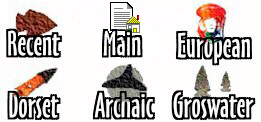![[Header]](cuttinghead.jpg)
![[Header]](cuttinghead.jpg)
The
Groswater Paleoeskimos' method
of making an endblade
1. Select a core of chert to work with.
2. Using a hammer stone, remove the weathered surface of the core, breaking it into smaller flakes.
3. Hit the end of the flake with hammerstone to make a flat surface.
4. Using a soapstone or quartzite tool, rasp the edge of the flat surface to make it rough.
5. Long thin straight-sided blades are broken off by using a soft "chisel" made from caribou antler and used in conjunction with the hammerstone.
6. The Blade is worked with an antler wand to create a sharp point and a base that fits tightly into the head of a harpoon. Side notches at the base are punched out by using an antler punch, and the inside of each notch is ground smooth so it does not cut the binding material used in lashing.
7. A very fine saw-tooth edge can be created by further shaping.
8. The underside of the blade is ground and polished.
![]()
What The Tools Tell Us
Each cultural group at Port au Choix had their own variations and styles of stone tools. The difference in how they look and how they were made helps archaeologists determine what tools belong to which cultures. Of all the tools made by the prehistoric peoples of the area, endblades - the sharp tips used on harpoons - are the most distinctive and are most easily identified by type and culture.
![]()
Follow These Links
Cutting Edge Technology
![]()
